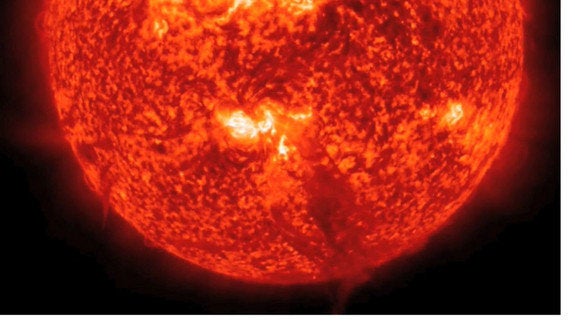
If you live in the lower 48, you may never have seen the Northern Lights. This spectacular display is generated when high energy particles from the sun collide with atoms in the high atmosphere creating undulating draperies of multicolored light arrayed along the lines of the earth's magnetic field.
The phenomenon of the Aurora Borealis is common in polar regions, but rarely seen elsewhere. And that is a good thing, because when the aurora moves south, it is the sign of a solar storm, an event caused by a massive solar flare which can have disastrous consequences for our electric grid. A solar storm in March 1989 caused a blackout in Quebec which left millions of people without electricity for 9 hours, and cost the region an estimated 2 billion dollars, closing hospitals and halting trading on Toronto's stock market.
This may have been a preview of what lies in store for us in the next couple of years as sun activity is expected to steadily increase, reaching its maximum strength in 2013, according to a prediction issued by NASA together with NOA, the National Oceanic and Atmospheric Administration.
Solar activity peaks every 11 years sending waves of charged particles careening toward the earth at speeds over 1,000 miles an hour. Much of this energy is absorbed by the upper atmosphere, but some of it gets through and hits the surface of the earth -- fortunately at levels too low to cause direct damage to humans. It can, however, interfere with the high power transmission lines which crisscross the U.S. When these lines get overloaded, they can knock out and sometimes destroy the transformers whose task it is to step down the voltage which passes through them. This is what led to the blackout in Quebec.
But scientists know that vastly larger and more destructive solar storms than this are not just possible, but inevitable. The last recorded Solar Superstorm called the "Carrington Event" occurred over a period of nine days in 1859. It is is believed to have been caused by an explosion on the sun equivalent in force to a billion hydrogen bombs. Auroras were seen as far south as the Caribbean, and telegraph networks failed across the Northern Hemisphere, in some cases even catching fire.
Nobody knows when another storm of this size will envelop our planet, but a recent estimate published in the International Journal of Research and Applications says that there is a one in eight chance of this happening within the next decade. If it does, electrical grids throughout the world will not just fail, but be destroyed. NASA warns that such an event would cause "an avalanche of blackouts carried across continents [that] ... could last for weeks to months."
After Hurricane Andrew in 1992, every spare small transformer in the U.S. was used to restore the damaged electrical grid in South Florida. A Solar Superstorm would multiply this destruction a thousandfold and be utterly impossible to repair in a timely manner.
And if this were not bad enough, the loss of power to nuclear power plants would threaten to create a whole string of Fukushima-type disasters around the globe. The core meltdowns at the Dai-ichi facility last March were not caused directly by the earthquake and tsunami which followed, but by the loss of power to the reactor cooling systems which made the nuclear fuel rods overheat. A potential loss of power for weeks at a time, such as would result from a Solar Superstorm, could overwhelm the capacity of emergency electrical power systems at nuclear generating plants to cope, according to a 2011 report by the Oak Ridge National Laboratory.
That is the bad news. The good news is that the problem can be solved -- in the U.S. at least -- by a one billion dollar investment in new equipment. That is one twentieth of what the military spends every year for air-conditioning in Iraq and Afghanistan. For that amount we could harden the vulnerable transformers, install ground resistors and create replacement parts for our imperiled electric grid, according to Earth Island Journal.
Nearly two years ago the House passed a bill that would clear the way for these vital safeguards to be put in place. But so far the Senate has failed to ratify the measure. Their continued stonewalling on Solar Shield Bill HR 668 is putting us all at risk.
(An earlier version of this piece appeared in the New York Daily News.)